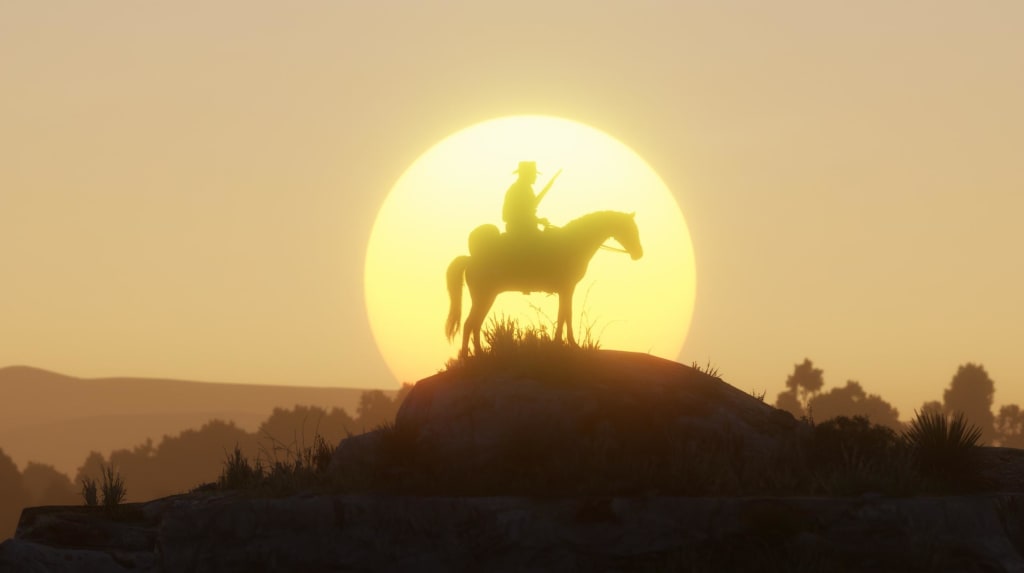True Role-Playing in 'Red Dead Redemption 2'
How New Technology Influences Game Design

One of the great pleasures that has been afforded to me in my post-graduate life has been the opportunity to re-enter the world of video games. Due to a lack of time, lack of disposable income, and racking sense of guilt, anytime I wasn’t doing something directly connected to my career pursuits, I had to step away from gaming for the duration of my college career. Now (with the aid of a cheap Black Friday PS4) I have plunged back into the gaming sphere, and coming back to games in 2019 is like not seeing a movie between 1983 and 2005. I’ve been amazed with the massive leaps and bounds that have been made on technical and narrative fronts. Even through only a small handful of titles, I’ve started reengaging with one of the most fertile grounds of creativity and storytelling.
Sometimes it can be hard to quantify the creative progress that occurs in a medium, especially when compared to the technological progress that usually accompanies it. It’s easy to assign new, better numbers to the technical aspects, such as screens/cameras being able to capture "X" more pixels or processors being able to render something "X" seconds faster, but charting the progress of what can be achieved with the new technology is a much more difficult venture. However, the stars have aligned and I was able to find a perfect cause-and-effect relationship between technical and creative progress in the form of Rockstar’s 2018 mega-sandbox Red Dead Redemption 2.
Red Dead Redemption 2 is a game in which you play a cowboy. It is an aptly named sequel to Red Dead Redemption, in which you also play a cowboy (albeit a different cowboy). On a macro level, these games are very similar, involving gunfights and horse-riding and taming the Old West. However, I was not a fan of RDR1 and could never be motivated to finish the game, as opposed to RDR2, which I expect to not only finish, but lick the crumbs off the plate when I’m done. So why the affinity for the second game and not the first?
In layman’s terms, the hardware specs on RDR2 are preposterous. It takes up five times as much storage space as most other video games currently on the market, has almost zero in-game load time, and several other numbers as well. The tech is so advanced and the game so well crafted that I can play for numerous in-game days without ever having to wait for a load screen. There is a level of unbroken involvement that was simply not possible before the current generation of games. But that alone is not the reason why I am so absorbed with RDR2. Last year’s Spider-Man PS4 could boast many of the same features, but I never thought about that game after beating the story campaign. My obsession with RDR2 comes from how Rockstar has been able to craft an experience in a space where it has never existed before, using the new tech to create a player narrative in the cracks of the overarching story of the game.
Arthur Morgan, the protagonist of RDR2, responds to the world very realistically. His facial hair grows if you don’t shave it, he starts to develop odor and attract flies if he doesn’t bathe, he can get too cold or too hot depending on his clothing and his environment, and he can even get fat if he eats too much food and doesn’t exercise enough. These mechanics have nothing to do with the story of the game—the narrative unfolds the same way whether Arthur is fat or skinny or dirty or clean—so it would seem that all this is superfluous detail, added in just to boast about the “more-ness” of this game over its predecessor. And yet, it introduces character choice in a subtle way that exists independent of the plot, to the point where it dictates how you, the player, actually interact with the game.
For example, you may meet a computer character in the game who asks you for some food. You can either give that person some of your food, or tell them to shove off. This is a narrative choice, in that it informs the way that the story of the game will proceed. But the realistic reactions Arthur has to his day-to-day life, and the close eye you are forced to keep on said reactions, cause you to make ludo-narrative choices, choices that inform the way you personally play the game. For instance, choosing to leave Arthur fat and smelly and unshaven did not change the story of the game, but it changed the way I literally controlled the character. As a hulking wild bear of a man, my Arthur charged into battle guns-blazing, never worrying about taking cover or being hit. Contrast this with the play-it-safe, hide-behind-cover approach that I took at the beginning of the game, when Arthur was clean and slim. But the craziest part is that, whenever I change his appearance in some way, I change the way I play the character. The way I play as and control Arthur changes depending on the condition his character is in, not based on any story reasons. Simply put, it is true role-playing. It is never an intentional choice on my part, but the mechanics of the game are causing me to play in a vastly different way depending on each different set of seemingly meaningless circumstances.
One of my favorite gaming moments occurred when I played the original Gears of War. There was a level in which creatures would attack you if you stayed in the dark parts of the map too long, so you are forced to cling to lampposts on a city street. When I stopped playing, I found myself hopping between patches of light on the ground in my own house. Great game design can rewire your brain to think and behave in a certain way (within the ramifications of the game, of course. Video games do not cause outward aggression or violence, and there are dozens of studies that confirm this that you may peruse to your liking), but it is something that is inherently tied to the technical limitations of the medium at any one time. The visionaries within the video game industry, as with visionaries in any creative field, are the people who are able to see a way to utilize the new technology for narrative purposes. Just as Stanley Kubrick was able to revolutionize cinematic storytelling with new technology in 2001, so too have the good people at Rockstar pushed the envelope of what is possible in interact narrative. And in a field where the tech is advancing literally every day, I can’t wait to see what the next software updates will bring.






Comments
There are no comments for this story
Be the first to respond and start the conversation.